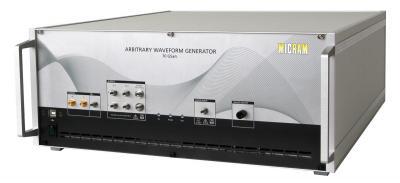Fast and faster: the cutting edge of transmission
The world's fastest arbitrary waveform generator for testing transmission techniques could help boost bandwidth on communications networks.
Primarily as a result of data-intensive applications, today’s communication networks are sometimes pushed to the limits of their capacity - and there is a real danger of traffic jams on the information superhighway. In future, only an improved infrastructure will suffice to quickly and reliably transport the growing masses of bits and bytes. However, as with conventional transportation, simply building new ‘roads’ is not a realistic option with these virtual networks.
“The available radiofrequency spectrum is already largely exhausted in many places. This means that we have to use the existing frequencies more efficiently,” explains Dr Klaus-Dieter Langer from the Fraunhofer Institute for Telecommunications, Heinrich Hertz Institute, in Berlin. The same goes for the landline network: exploiting existing capacities with state-of-the-art technology is often cheaper than laying new cables.
Consequently, Langer and his team are working on transmitting more information in less bandwidth. To achieve this goal, they are testing out new modulation formats for fibre-optic transmission technology in an attempt to accommodate as many bits as possible in a frequency unit. While the simplest modulation format consists of a sequence of 0s and 1s, the researchers’ concepts may involve adding several intermediate values, for instance, in order to obtain a higher bit rate.
“Although complex modulation formats often seem very promising in theory, they can turn out to have unexpected effects when we test them,” says Langer.
In order to test the practicability of new transmission techniques, researchers usually use signal generators. More sophisticated versions - arbitrary waveform generators, or AWGs - are capable of creating random sequences of signals. Such a tool can make life much easier for researchers and developers. “Otherwise, we would have to construct specific circuits for the required signals. And that would be far too time-consuming, particularly with complicated signal forms,” explains Langer.

Researchers at the Fraunhofer HHI have developed what is currently the fastest AWG in the world. With sample rates of 70 GSa/s - that is, 70 billion sample values a second - it is possible to quickly and easily simulate any kind of scenario with very high data rates and signal frequencies. The AWG is based on two digital-to-analog converters with 35 GSa/s each and the highest bandwidth available on the market.
As well as testing new modulation formats, the high-end AWG can also be used to optimise existing transmission methods: “For example, we can deliberately impair the signal to find out how tolerant the transmission is to signal fluctuations and to identify any points of weakness,” says Langer.
The findings can help to improve transmission techniques for existing broadband and radio networks, making them better able to cope with the constantly growing flood of data.
2025–26 Thought Leaders: Tim Karamitos
Tim Karamitos from Ericsson discusses the connectivity requirements of emergency services and...
2025–26 Thought Leaders: Ruth Tovo
Comms Connect panellist Ruth Tovo, from the South Australian SES, discusses the technical...
ARCIA update: celebrating excellence in our industry
The ARCIA Annual Gala Dinner and Excellence Awards took place during the same week as Comms...




